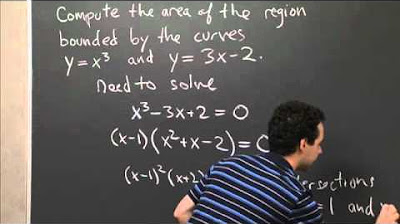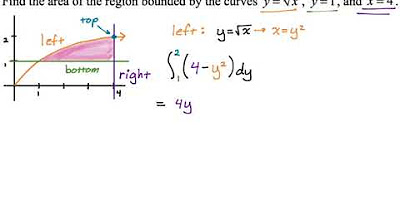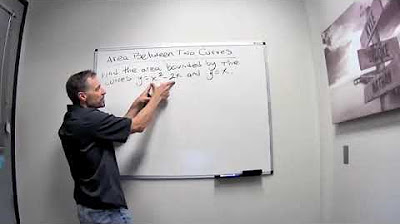Area of a Region Between Two Curves
TLDRThis educational video teaches how to find the area between two curves. It covers two scenarios: functions of X (e.g., 3-x^2 and -x+1) and functions of Y (e.g., 5-y^2 and y-1). The key is integrating the top function minus the bottom function for X-based functions and right minus left for Y-based functions. Examples illustrate the process, emphasizing the importance of finding intersection points and correctly setting up integrals.
Takeaways
- 📚 The lesson is about finding the area between two curves, which can be functions of either x or y.
- 📈 When dealing with functions of x, the area is found by integrating the top function minus the bottom function over the interval [a, b].
- 📉 For functions of y, the area is calculated by integrating the right function minus the left function, with the integral taken from the y-values [a, b].
- 🔍 To find the area between two functions, first determine the intersection points of the curves.
- 📝 The example given involves finding the area bounded by the graphs of y = 3 - x^2 and y = -x + 1, which are both functions of x.
- 🧩 The intersection points of the functions are found by setting them equal to each other and solving for x.
- ✂️ The integral to find the area involves subtracting the lower function from the upper function and evaluating between the intersection points.
- 📐 The second example involves functions of y, with x = y^2 and y = x + 1, and requires finding the y-values where they intersect.
- 🔢 The integral for functions of y involves subtracting the left function from the right function, with the integral taken over the y-interval.
- 📉 It's important to check the order of the functions to ensure the correct function is on top or bottom when setting up the integral.
- 🔄 If the curves switch positions, it may be necessary to set up multiple integrals to find the total area between the curves.
Q & A
What is the primary method for finding the area between two curves?
-The primary method involves integrating the difference between the two functions (top function minus bottom function) over the interval defined by the intersection points of the curves.
What is the significance of the intersection points of two curves in finding the area between them?
-The intersection points are the boundaries of the interval over which the integral is evaluated to find the area between the curves.
How does the orientation of the curves affect the calculation of the area between them?
-The orientation determines whether the area is calculated as 'top minus bottom' or 'right minus left', depending on whether the functions are functions of x or y.
What is the formula used when the functions are functions of x?
-The formula used is the integral from a to b of (F(x) - G(x)) dx, where F(x) is the top function and G(x) is the bottom function.
What is the formula used when the functions are functions of y?
-The formula used is the integral from a to b of (G(y) - F(y)) dy, where F(y) is the left function and G(y) is the right function.
How do you determine the functions that are on top and bottom when integrating?
-You determine which function is on top by comparing their values at any point in the interval. The function with the higher value is on top.
What is the process for finding the intersection points of two curves?
-Set the two functions equal to each other and solve for the variable to find the intersection points.
Can the order of the functions (top and bottom) change in different regions of the graph?
-Yes, the order can change, and it is necessary to set up different integrals for different regions where the functions switch positions.
What is an example of a function of x that is used in the script?
-An example given in the script is y = 3 - x^2, which is an upside-down parabola shifted up by 3 units.
What is an example of a function of y that is used in the script?
-An example given in the script is x = 5 - y^2, which is a sideways parabola.
How do you handle multiple regions between curves when calculating the total area?
-You set up separate integrals for each region, ensuring that the correct functions are used as top and bottom based on their position in each region.
Outlines
📚 Introduction to Finding Area Between Curves
This paragraph introduces the concept of calculating the area between two curves. It explains that there are two types of functions involved: one is a function of X (denoted as F) and the other is also a function of X (denoted as G). The key to finding the area between these curves is to integrate from a value 'a' to 'b', using the formula of the top function minus the bottom function. The explanation also touches on the scenario where functions are given as X in terms of Y, and how to approach finding the area in such cases by integrating with respect to Y, using right minus left for functions of Y.
📐 Calculating Area with Functions of X
The second paragraph delves into a practical example of finding the area between two functions of X: y = 3 - x^2 (an upside-down parabola shifted upwards) and y = -x + 1 (a straight line with a negative slope). The intersection points of these functions are calculated by setting them equal to each other, resulting in x values of -1 and 2. The area between the curves is then found by integrating from x = -1 to x = 2, using the formula for the top function minus the bottom function. The integral is simplified, and the antiderivative is calculated, followed by evaluating the result at the bounds to find the area, which is approximately 4 and 1/2 square units.
📉 Area Calculation with Functions of Y
This paragraph discusses the process of finding the area between two functions of Y, using the example of y = 5 - y^2 (a sideways parabola) and y = x + 1 (a straight line). The intersection points are determined by solving a quadratic equation, yielding y values of -3 and 2. The area calculation involves integrating from y = -3 to y = 2, using the right function minus the left function approach. The paragraph encourages the viewer to perform the integration and evaluate the result to find the area between the curves, emphasizing the importance of checking the order of functions to ensure accuracy in the calculation.
Mindmap
Keywords
💡Area
💡Integration
💡Functions of X
💡Top Function Minus Bottom Function
💡Intersection Points
💡Functions of Y
💡Right Minus Left
💡Antiderivative
💡Evaluating the Integral
💡Multiple Integrals
Highlights
Introduction to finding the area between two curves.
Two types of functions to deal with: one as a function of X (F) and another as a function of X (G).
Method for finding area between curves: integrate between values a and B, always top function minus bottom function.
Handling functions of Y, integrate between Y values a and B, right function minus left function.
Example: Area bounded by y = 3 - x^2 and y = -x + 1.
Intersection points needed for integral bounds: set equations equal to find where graphs intersect.
Solving for intersection points: algebraic manipulation to find x values.
Integration method for functions of X: integrate (top function - bottom function) between intersection points.
Antiderivative calculation for the integral.
Evaluating the integral: plug in upper and lower bounds to find the area.
Final area calculation between curves.
Second example: Area bounded by x = y^2 and x = y + 1.
Finding intersection points for functions of Y: solve equations to find Y values.
Integration method for functions of Y: integrate (right function - left function) between Y values.
Handling multiple regions: set up multiple integrals for different regions.
Checking order of functions: ensure correct order for top and bottom functions in integrals.
Transcripts
Browse More Related Video
5.0 / 5 (0 votes)
Thanks for rating:





